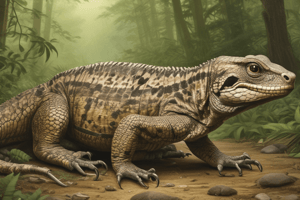Podcast
Questions and Answers
Reptiles are warm-blooded, meaning they regulate their body temperature internally.
Reptiles are warm-blooded, meaning they regulate their body temperature internally.
False (B)
All reptiles have external ear openings.
All reptiles have external ear openings.
False (B)
Tuataras are a type of lizard.
Tuataras are a type of lizard.
False (B)
Some reptiles have venom or toxic secretions as a defense mechanism.
Some reptiles have venom or toxic secretions as a defense mechanism.
Reptiles have a more complex brain structure than mammals and birds.
Reptiles have a more complex brain structure than mammals and birds.
All reptiles lay eggs.
All reptiles lay eggs.
Study Notes
Characteristics
- Cold-blooded: regulate body temperature using external sources
- Scaly skin: prevents water loss and provides protection
- Lay eggs: oviparous
- Respiratory system: lungs or skin breathing
- Brain structure: simpler than mammals and birds
Types of Reptiles
- Snakes (Squamata)
- No legs or eyelids
- Specialized skin and muscles for movement
- Venomous or constricting predators
- Lizards (Squamata)
- Legs present
- External ear openings
- Most species are carnivorous
- Turtles (Testudines)
- Shell: bony plates (scutes) on back and belly
- Flipper-like limbs or webbed feet
- Omnivorous or herbivorous
- Crocodilians (Crocodilia)
- Large, carnivorous predators
- Armored skin with scutes
- Strong tails for swimming
- Tuataras (Sphenodontia)
- Only living species: Sphenodon punctatus
- Native to New Zealand
- Triangular head, spiny crest on back
Adaptations and Defense Mechanisms
- Camouflage and color change
- Venom or toxic secretions
- Spines, quills, or armor plating
- Playing dead (thanatosis)
- Sun-basking and thermoregulation
Characteristics of Reptiles
- Reptiles are cold-blooded, meaning they regulate their body temperature using external sources
- They have scaly skin, which prevents water loss and provides protection
- Reptiles are oviparous, meaning they lay eggs
- They have a unique respiratory system that uses lungs or skin for breathing
- The brain structure of reptiles is simpler than that of mammals and birds
Types of Reptiles
Snakes
- Snakes have no legs or eyelids
- They have specialized skin and muscles that enable them to move
- Snakes are either venomous or constricting predators
Lizards
- Lizards have legs present
- They have external ear openings
- Most lizard species are carnivorous
Turtles
- Turtles have a shell that is made up of bony plates (scutes) on their back and belly
- They have flipper-like limbs or webbed feet
- Turtles are omnivorous or herbivorous
Crocodilians
- Crocodilians are large, carnivorous predators
- They have armored skin with scutes
- They have strong tails that are used for swimming
Tuataras
- The only living species of tuatara is Sphenodon punctatus
- Tuataras are native to New Zealand
- They have a triangular head and a spiny crest on their back
Adaptations and Defense Mechanisms
- Reptiles use camouflage and color change to adapt to their environment
- They have venom or toxic secretions to defend themselves
- Some reptiles have spines, quills, or armor plating to protect themselves
- Reptiles can play dead (thanatosis) to defend themselves
- They use sun-basking and thermoregulation to regulate their body temperature
Studying That Suits You
Use AI to generate personalized quizzes and flashcards to suit your learning preferences.
Description
Learn about the key characteristics and types of reptiles, including snakes and lizards. Understand their unique features and adaptations.




